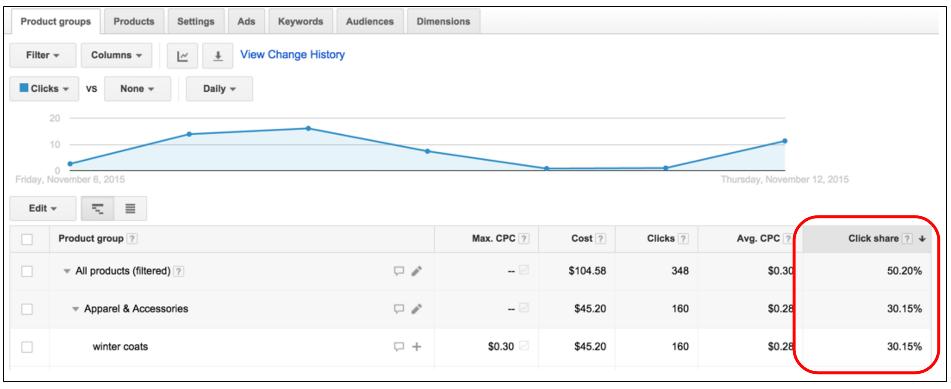Identify Missing Traffic With New Google Shopping Click Share

Google recently announced a new metric called “Click share” that can be used to help retailers identify when they are potentially missing out on traffic.
As seen in the example below, Click share is calculated by the clicks a retailer received on the Search Network divided by the estimated maximum number of clicks that they could have received.
Pro-Tip: Data is available at the product group level for Shopping campaigns only.

Similar to impression share, Google analyzes the ad auctions over the course of the day and includes all auctions that your ad showed in or your ad was competitive in.
To estimate click share percentage, Google compares the number of clicks your ad actually received with the maximum number of clicks you could have received.
The maximum number of clicks an ad could receive depends on the prominence of your ads number of ads you show for a search query, bid, and overall quality and relevance of your ads.
1) Add the click share column – This will be located on the Product groups tab.
2) Analyze your click share – In the above example, we can see that “winter coats” has a click share of 30%. What this means is that, you only got 30 out of every 100 possible clicks on your “winter coats” ads. According to Google, this should be identified as “an opportunity to adjust your bids for ‘winter coats’ to make them more prominent”. (See below for more tips on how to increase Click share)
3) Check back frequently – Especially for your most popular products, it’s critical to closely monitor click share and continue to optimize bids based on this percentage.
Click share can be used to identify product groups with potential for more traffic to ensure your ads show prominently enough to maximize traffic to your site.
To understand the value of click share, you can compare it to the results you see for impression share. While impression share tells you about your share of eligible impressions, click share tells you the share of clicks you could get for the eligible impressions.
Essentially, even if your impression share is very high (for example 100%), you may still only receive a small number of clicks.
Retailers can use click share to understand how close they are to receiving the maximum number of possible clicks. In comparison to Impression share, Click share gives retailers more insight into the effectiveness of their product titles, images from a relevancy and copy standpoint.
It’s important for retailers to understand that they need to get impressions BEFORE they can get clicks. Any efforts to increase impression share could also be useful for increasing the click share percentage. The gap is that even if you reach a high impression share (as seen above) it doesn’t guarantee a high click share because there are other factors involved including bid, quality and ad relevance.
Increasing your bid and the quality and relevance of your ads can help your ads get higher positions and more clicks.
Remember that multiple Product Listing Ads from the same advertiser can show at the same time. When you have multiple ads showing at the same time, you increase your chance for having any of your ads clicked. So, you can increase overall click share by having more than one of your products show.
“I do not think this metric will carry a lot of weight initially for retailers using an ROI-driven strategy. Most simply put, the goal is usually to bid as highly as possible while still maintaining profitability, and any metric telling a retailer to bid above their profitability, is really not too useful of a metric,” Josh Brisco, Senior Retail Search Manager at CPC Strategy said.
“For retailers who are more branding/exposure focused, this may be more useful. Impression share (though a pretty ‘fuzzy’ metric in Shopping to begin with) is still the measuring stick metric for this approach, but if a retailer does have solid IS but poor Click Share, they may want to look at pricing, ad positioning, or other factors which may lead them to no be winning clicks that they theoretically could be.”
“Though we don’t yet have a firm grip on the correlation between IS and CS, once loosely established, this could also be used for more ROI-sensitive retailers to analyze why they may have solid IS, but relatively poor CS.”
